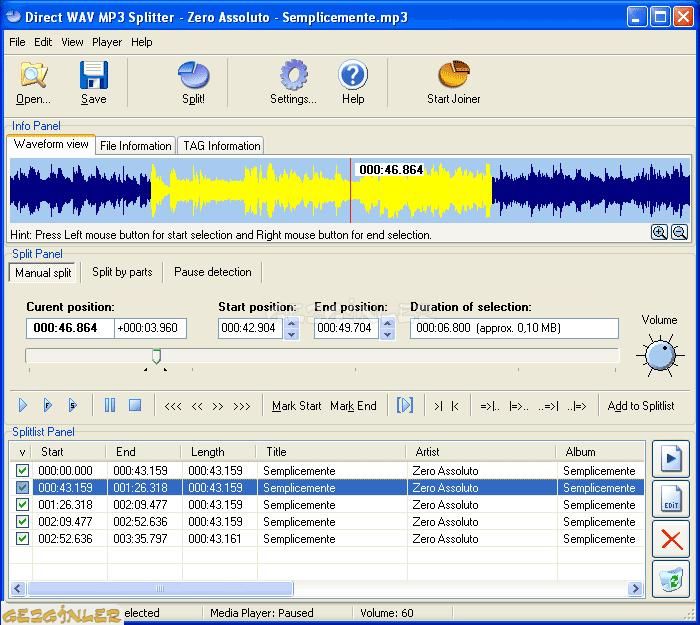

- AUTOMATIC MP3 SPLITTER HOW TO
- AUTOMATIC MP3 SPLITTER INSTALL
- AUTOMATIC MP3 SPLITTER SOFTWARE
- AUTOMATIC MP3 SPLITTER DOWNLOAD
If you’re wondering how long this takes - it took about five-and-a-half minutes on my fairly underpowered (by modern standards) workstation. test_srt.py Fantastic\ Mr\ Fox.wav > Fantastic\ Mr\ Fox.srt Now we can run Vosk to convert the speech in the audiobook to text!: python3. The model is the pre-trained ML layers that encode what has been learnt about speech, i.e.
AUTOMATIC MP3 SPLITTER DOWNLOAD
First, we download the English language trained models: git clone ffmpeg -i Fantastic\ Mr\ Fox.mp3 -ar 16000 -ac 1 Fantastic\ Mr\ Fox.wav


So long as the decoded WAV file’s durations are the same, the original source can be used as the subject of the split. So, I used ffmpeg to decode the audiobook’s MP3 files. It’s unlikely that your audio file is in that format, and this one certainly wasn’t. Vosk requires a decoded mono WAV file with a sample rate of 16kHz.
AUTOMATIC MP3 SPLITTER INSTALL
Once that was done, installing was as simple as: $ pip3 install vosk First, I needed to get Python3 and pip up to date. I followed the installation instructions for Vosk. If you're not a geek, just ignore those bits, I'll try to describe what I found and my results regardless of how I did it. " Really easy to get started with" is a relative phrase the instructions below are really only for geeks (by which I mean: someone very comfortable with computers). It turns out that Vosk is really easy to get started with.
AUTOMATIC MP3 SPLITTER SOFTWARE
However, I figured it would be easier to get up and running with some software on my own computer - I am a self hoster after all! These are used by automated translation services you might have on your smartphone. You might already have used one - examples are IBM Watson and Google Cloud Speech. There are a number of speech-to-text services out there. Finding the chapter breaks with machine learning using Vosk It can be frustrating to scan from silence to silence looking for the correct gap.īeing a geek, I thought… how about we apply AI (Artificial Intelligence) to the problem? In this case - a form of AI called machine learning (ML). Points of silence in the waveform may be the start of a chapter… or they may not. Regardless of the tool you use, the disadvantage of this is that it’s quite manual. Good luck finding the chapter breaks there… The ‘traditional’ solution to finding the chapter start points is to use an audio editor or viewer to view the waveform of the audio file and discern where the chapters start from there.Ī common solution is Audacity but if you’re just looking for the cut points then an online viewer could work - take a look at - no uploading involved.
AUTOMATIC MP3 SPLITTER HOW TO

Your music player might be sophisticated and remember your position in a particular file but many aren’t. It’s typical you won’t finish the audiobook in one sitting. What’s the problem with one MP3 file? Mainly: seeking. For smaller books you might get away with it, but for some of the books in that collection, such as Charlie and the Chocolate Factory, you’re talking about one unwieldy MP3 file ( I would normally rip a CD in FLAC format, but in this CD boxset the audio actually comes as an MP3 file on a data CD). Monolithic audiobooks are audiobooks packaged in one audio file. But there was always one problem with that particular boxset: monolithic audiobooks. The organisation scheme I derived has proven itself pretty useful. Splitting audiobooks into chapters with AI and crossed fingersĪbout a year ago I blogged about organising audiobook boxset files.


 0 kommentar(er)
0 kommentar(er)
